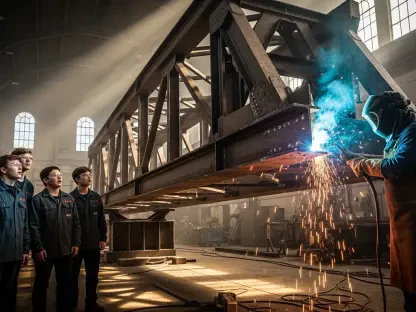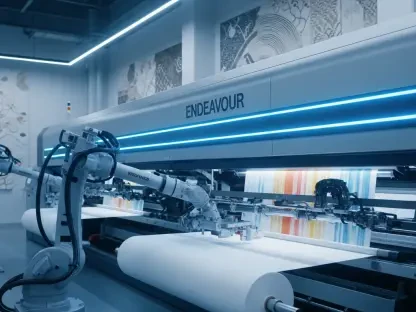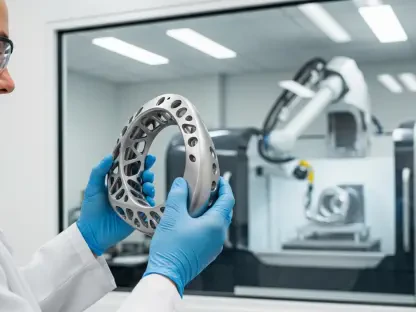In the fast-paced world of industrial material handling, where efficiency can make or break production timelines, U-Trough Feeder technology stands as a cornerstone for managing dry bulk materials. Picture a bustling food processing plant, where every gram of flour or sugar must flow seamlessly to meet stringent quality standards, or a chemical manufacturing facility grappling with abrasive powders that threaten equipment longevity. These scenarios underscore a critical challenge: achieving consistent, reliable material flow without compromising safety or precision. This review delves into the intricacies of U-Trough Feeders, exploring their design, innovations, and real-world impact, while shedding light on how they address such pressing industrial demands.
Core Design and Functionality
U-Trough Feeders are engineered to handle dry bulk materials such as powders, pellets, and granules with remarkable consistency. Their signature trough-shaped design, paired with a screw mechanism, facilitates uniform material movement, making them indispensable in industries requiring precise dosing and continuous flow. The fundamental principle lies in the balance between structural simplicity and operational efficiency, ensuring that materials are transported without clogging or interruption, even under high-volume conditions.
Beyond the basic structure, the technology’s adaptability to various material properties sets it apart. Whether dealing with lightweight powders or dense granules, the screw and trough configuration can be adjusted to maintain steady delivery. This flexibility not only enhances production rates but also minimizes downtime, a key concern for sectors like food production and chemical processing where delays can be costly. The design’s focus on streamlined flow reflects a deep understanding of industrial needs.
Key Features and Technical Highlights
Internal Agitation Mechanisms
A standout feature of modern U-Trough Feeders is the internal agitation system integrated within the hopper. This mechanism actively prevents material clumping and bridging—common issues with cohesive substances like cocoa powder or damp mixtures—by breaking up aggregates before they reach the screw. Such a system ensures that even challenging materials flow smoothly into the feeding process.
The ability to adjust agitator speeds further enhances this feature’s effectiveness. Operators can fine-tune the agitation based on specific material characteristics, preventing overworking the system or causing unnecessary wear. This adaptability proves vital in maintaining consistent output, especially when handling batches with varying densities or moisture levels, thereby reducing the risk of production bottlenecks.
Precision Motor Controls
Precision is another hallmark of U-Trough Feeder technology, largely due to independent motor controls for the agitator and drive screw. This dual-control setup allows for meticulous calibration, ensuring that each component operates at optimal levels for the task at hand. Such granularity in operation translates to improved dosing accuracy and material handling efficiency.
Additionally, the incorporation of volumetric and gravimetric control systems caters to diverse industrial requirements. Gravimetric feeders, in particular, stand out for their weight-based measurement approach, offering superior precision for applications where exact quantities are non-negotiable, such as pharmaceutical blending. This level of control underscores the technology’s role in meeting stringent industry standards.
Innovations and Market Trends
Recent advancements in U-Trough Feeder technology reflect a strong push toward safety and durability. Bolt-on components, such as nozzles and protective grates, have become standard in many designs, minimizing risks associated with maintenance access and accidental contact with moving parts. These innovations address long-standing safety concerns while simplifying upkeep, a significant improvement over older, less secure clamping systems.
Material advancements also play a pivotal role, with stainless steel—often in grades like 304 or 316—becoming the norm for construction due to its corrosion resistance and ease of cleaning. This shift is particularly relevant for industries with strict hygiene protocols, ensuring compliance without sacrificing equipment lifespan. The trend toward using robust materials signals a broader commitment to reliability in harsh operational environments.
Moreover, customization has emerged as a dominant trend, driven by the need to handle an increasingly diverse range of materials. From tailored screw types to modular hopper extensions, manufacturers are prioritizing flexibility to meet unique client needs. This focus on bespoke solutions, coupled with a growing emphasis on precision-driven systems in sectors like food and pharmaceuticals, indicates a market increasingly oriented toward specialized performance.
Applications Across Industries
The versatility of U-Trough Feeders shines through in their widespread adoption across multiple sectors. In food processing, they manage ingredients like flour, sugar, and spices with finesse, ensuring uniform delivery for consistent product quality. Their ability to handle delicate or sticky materials without clogging makes them a preferred choice for maintaining production integrity in this field.
In chemical manufacturing, these feeders tackle the challenges posed by abrasive or corrosive powders and granules. Tailored configurations, such as reinforced screws or specialized coatings, enable them to withstand harsh conditions while preventing contamination—a critical factor in maintaining output purity. This adaptability highlights their value in high-stakes environments where material integrity is paramount.
Specific implementations further illustrate their capability, with some systems achieving dosing accuracy as tight as 0.5% in precision-critical applications. Such performance, often seen in setups designed for high-fat content materials or uniquely abrasive substances, demonstrates how far the technology has come in addressing niche operational demands. These real-world examples cement the feeder’s reputation as a reliable industrial tool.
Challenges in Implementation
Despite their strengths, U-Trough Feeders are not without operational hurdles. Material clumping and inconsistent flow rates remain persistent issues, particularly with substances prone to bridging under pressure or moisture. These disruptions can lead to uneven feeding, impacting downstream processes and necessitating frequent manual intervention to clear blockages.
Wear and tear from abrasive or corrosive materials also pose significant challenges, often accelerating component degradation. This issue not only shortens equipment lifespan but also raises the risk of contamination in sensitive applications. While modern materials like stainless steel mitigate some of these effects, the need for ongoing durability improvements remains a pressing concern for many operators.
Safety and regulatory compliance add another layer of complexity. Traditional designs sometimes hinder safe maintenance access, increasing accident risks, though newer bolt-on features offer promising solutions. Additionally, meeting hygiene standards in industries like food processing requires constant vigilance, pushing manufacturers to refine designs for easier cleaning and stricter adherence to guidelines.
Looking Ahead: Future Potential
The trajectory of U-Trough Feeder technology points toward greater integration with automation and smart systems. Real-time monitoring capabilities, enabled by advanced sensors, are on the horizon, promising to optimize flow rates and detect issues before they escalate. Such developments could redefine operational efficiency by minimizing human oversight while maximizing output reliability.
Potential breakthroughs in material science may further enhance performance, with even more resilient coatings or alloys extending equipment life in corrosive environments. Additionally, AI-driven algorithms could fine-tune feeder operations dynamically, adapting to material variations on the fly. These innovations suggest a future where precision and durability are seamlessly balanced.
The long-term impact on industrial practices could be transformative, particularly in terms of sustainability and safety. As systems become more efficient, energy consumption and material waste may decrease, aligning with broader environmental goals. Simultaneously, enhanced safety features and automation could reduce workplace hazards, setting new benchmarks for operational standards across sectors.
Final Reflections
Looking back, this exploration of U-Trough Feeder technology reveals a robust solution that has adeptly met the demands of dry bulk material handling across diverse industries. The journey through its design intricacies, innovative strides, and practical applications highlights a tool that has significantly improved efficiency and precision in challenging environments. For industries seeking to enhance their material handling processes, the next steps involve investing in customizable configurations and prioritizing regular maintenance to combat wear and clumping issues. Exploring partnerships with manufacturers for material testing services could also unlock tailored setups for unique operational needs. As automation and advanced materials continue to shape the landscape, staying abreast of these developments will be crucial for maintaining a competitive edge in production efficiency and safety.









